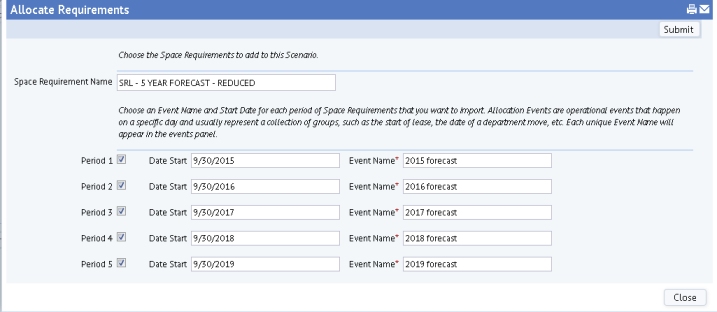Space / Space Planning
Real Property / Advanced Forecasting / Advanced Portfolio Forecasting
Concept: Forecast Space Requirements
A key aspect of space and portfolio management is planning for future needs and ensuring that you have enough space to accommodate future growth at various points in time. For example, if you are hiring new staff and opening new labs over the next two years, you need to ensure that you have the required space. Similarly, if you are planning to downsize, you want to know your expected needs so that you can prepare to get rid of unused space, which will result in significant cost savings.
With the Archibus space requirement features and Space & Portfolio Planning Console, you can forecast your space needs and then allocate your planned space in stack plans to see how your forecast needs match up against your space holdings. If downsizing, you can arrange you space so that you can fit in one building or one campus.
A forecast is a space requirement for which you have completed various Period fields (such as Period 2, Period 3, Period 4, and so om). The Period fields to track the expected growth, reduction, or movement of the organization for various time frames. You create forecasts at your desired level (business unit, division, department, functional group) and you enter the expected amount for each forecast period. Then, you bring the forecast space requirement into a portfolio scenario so that you can experiment with different arrangements of forecast space.
Like all space requirements, space forecasts are stored in Space Budgets and Space Budget Items tables. You know that a space requirements is a forecast space requirement because the space requirement items values for multiple Period fields.
Note: When using the Define Space Requirements task to define a forecast at the functional group level, you can estimate the amount of space each functional group will require over different forecast periods. You can then view this information in the Space Requirements chart. However, if you next define a portfolio scenario with the same name so that the forecast space requirement and portfolio scenario are linked, you cannot work with the various forecast periods on the stack plans. You will be limited to working with just Period 1.
General Procedure for Working with a Space Forecast
- Automatically create your baseline from inventory.
- Edit the generated space requirement items to complete the forecast amount for each period.
The generated baseline space requirement reflects your current inventory. You now must show how this inventory will change for each forecast period.
A space requirement item can hold up to 12 forecast periods. The number of Period fields that you complete will depend on the level of detail in your forecast. For example, you might have a high-level forecast in which you project needs for the next three years at an annual rate; in this case, you'd complete Periods 2, 3, and 4 to represent each year. (Note: the system completes the Period 1 fields with the same value as the baseline so that you have a starting point.) If you want to project quarterly needs for the next two years, you'd complete eight period fields. You associate the Period fields with time frames in Step 3, when you bring the space requirement into a portfolio scenario.
You complete the Period fields with the same unit as your baseline unit. For example, if you are projecting space based on headcounts, you'd complete the Period fields with the expected headcount for each period. If you are projecting based on room standards, you'd select the requirement for each room standard and enter the expected number of this standard for each forecast period. For example, the below image shows that the need for OFF-A offices will increase to 4 for Periods 3 and 4, representing anticipated growth.
- Bring the forecast requirement into a portfolio scenario.
Open a portfolio scenario in the Space & Portfolio Planning Console. Choose a forecast space requirement to add to the portfolio scenario, and the system presents the Allocate Requirements form so that you can create allocation events for the forecast periods defined in the space requirement (the Period fields). For example, in the below form for a five-year forecast, the user has defined a time frame for each forecast period field of the space requirement. These dates will become allocation events. Note that it is in this step that you associate each Period field with a time frame.
- Process the Allocate Requirements form, and the system generates allocation events for each forecast period and updates the current stack plan to show the forecast allocations for the currently active allocation event. The allocation areas are based on the number of units that you specified for each period in Step 2. For example, in Step 2 you forecast that you'd need four OFF-A offices for the Executive-Management department in Period 4. Accordingly, the stack plan for the Period 4 allocation event (the 2018 Forecast allocation event) will have a stack element (allocation) for Executive Management that represents the required area for four OFF-A offices.
- For each forecast period (allocation event), you can select the allocation event and use the corresponding stack plan to experiment with different configurations of the forecast space to determine the optimal arrangement. If you have forecast for growth, you may find that the allocations cannot fit within your current space and that you need to acquire more space. For information on working with the stack plans, see View and Work with Stack Plans.